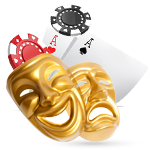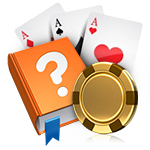The bluff
-
Tips for beginners
- Poker rules
- hands
- Texas Hold'em
- Texas Hold'em Cash Games
- Top 10 tips
- glossary
Tipps für Anfänger -
Basic strategies
- Chances of winning & odds
- Position
- The bluff
- Semi Bluffs
- Protect leaves
- 5-10 rule
- I can control
- Komfortlevel
- Value Bets
- River Play
- Turn Play
- Heads Up
Grundlegende Strategies -
Strategies for advanced users
- Implied Pot Odds
- Reverse Implied Odds
- Short Stacks
- Errors in Limit Ascension
- game schedule
- Far Ahead, Far Behind
- Blinds
- Draws
- Expected value
- Preflop
- Ranges
Strategies für Fortgeschrittene - Online Poker
-
Live Poker
- Live tournaments
- Online vs Offline
- All major live tournaments
Live Poker - Psychology and mindset
-
Other Poker Variants
- Omaha
- Omaha starting hands
- 5 Card Draw
- Pineapple Poker
- 7 Card Stud
- Triple Draw Lowball
Andere Poker Varianten
Unlike the semi-bluff, the classic bluff is a completely worthless hand that you play as if it were a strong hand. However, as a beginner, you should be cautious with this strategy because if you get caught, experienced players will use it against you in the following hands. Be mindful of the risks and use the classic bluff sparingly, only when you have a strong read on your opponents and believe they will fold to your strong betting.
The primary focus in bluffing is to maintain consistency throughout! Novice players often make the mistake of placing only a small bet when they have not hit anything on the board, in order to avoid losing too much money. However, for a bluff to be effective, the bets should be high enough to appear believable, as if one has a strong hand. This will likely prompt players holding a flush draw, for example, to fold their hand. To ensure the bluff's success, it is important to commit fully and make it appear convincing.
When should one bluff?
The situations presented below are merely intended as a rule of thumb for when bluffing is appropriate. In the game of poker, you will constantly find yourself in unpredictable situations that require quick decision-making.
-

With only a few active opponents:
It is evident that the fewer active participants there are, the greater your chances will be of successfully executing your bluff. Attempting a bluff with more than two active players often seems like an insurmountable task. Even two active participants can already pose a significant challenge.
-

If you are the last one to move:
If you find yourself in the last position, sitting in a favorable spot, this presents a fantastic opportunity to engage in some bluffing. For instance, if your opponents have checked before you, it's a strong indication that they're holding weak hands. Exploit this situation by making a sizable bet and ideally driving your opponents out of the pot. This strategic move can greatly increase your chances of success and give you an upper hand in the game.
-

If you raised preflop:
If you fail to hit anything on the flop after raising, there is still a chance for you to win the pot uncontested by making a continuation bet. However, be prepared to accept your losses and fold yourself if an opponent decides to call you.
-

Against opponents with a low number of chips:
If your opponent has a small stack, it is unlikely that they will call your raise unless they have a very good hand after the flop. However, be cautious here as players with small stacks, ranging from five to ten blinds, rarely call but instead usually either fold or go all-in. Take note and exercise caution when facing such situations in order to make the most optimal decisions.
-

On a draw:
If you have a draw like a flush draw instead of a made hand and decide to bluff, it is referred to as a semi-bluff. Ideally, you would win the pot uncontested, but even if someone calls, you still have a good chance of winning the pot with a nut hand. If you are raised in this situation, whether it is worth continuing in the hand depends on the pot odds. You should assess the situation and make a decision accordingly.
Choosing the right moment to bluff
The appropriate bet size should always be at least between half and three-quarters of the pot. However, if one gets called and their hand doesn't improve, it's better to fold. Experienced players sometimes follow up the first bluff on the turn with a second one in this situation, but less experienced players should avoid investing more money.
Beginners often bluff too frequently, believing it to be one of the most crucial aspects of poker. However, less is more in this case, and above all, it is essential to be able to assess opponents and always take a moment to evaluate the situation before deciding whether a bluff is appropriate and likely to succeed.
Recognize bluffs
No doubt you've experienced this scenario before: your opponent suddenly pushes a massive bet into the pot and then tauntingly challenges you to call. If they truly have a strong hand, you stand no chance of winning, but for some reason, you don't believe them. Just as you slide your chips into the center, the opponent angrily shakes their head and hisses, "that's your pot," discarding their cards.
It's an amazing experience to expose such a massive bluff, and some players are almost addicted to this feeling. However, there is a significant danger in doing so: when the opponent has a strong hand, they don't fold, but convince themselves that it's a bluff. They essentially persuade themselves to make a call, which occasionally reveals a bluff but more often leads to substantial losses. For the opponent, these players are a dream because they willingly walk into any premium hand without hesitation.
Do not rely on your intuition!
It is crucial for you to avoid such situations, thus acquiring the skill to detect bluffs becomes imperative. Instead of relying on intuition or waiting for an opponent who can't control their facial expressions, you need to adopt a more logical approach. By analyzing your opponent's bets in relation to the possible hands they could be playing, you can determine most common bluffs. If there are several hands that would make sense for your opponent's gameplay, it is likely that they possess one of those hands and it is not a bluff.
If, however, he plays a hand where bets on the flop and turn would make sense, but not on the river, then the last bet might be a bluff. This is especially plausible when the flop has allowed for several draws, none of which have been hit by the river. In such a scenario, the number of possible strong hands is low, whereas the number of weak hands is high, indicating a high probability that your opponent does not have a good hand!
The top 5 poker bluffs of all time: a definitive list.
Examples of analyzing poker bluffs
To illustrate, let's consider two scenarios where your own hand doesn't matter, but it is assumed that you're attempting to bluff. Allow me to present two instances for clarity.
Example 1:
In the first hand of the game, you and your opponent are playing with blinds of $1/$2 and both have $200 in chips. Your opponent raises to $8, and you and another player choose to call, while the small blind folds. The flop reveals the cards 10, 8, Q. You decide to check, and your opponent bets $20 into the pot, which currently has $25. You call the bet, and the third player folds. The turn brings a 5. Again, you choose to check, and your opponent bets $30 into the pot, which now totals $65. After your call, the river card is revealed as a 6. Once more, you check, and your opponent places a bet of $55 into the pot, which is now at $125.
The opponent has made a pre-flop bet, followed by bets on the flop against two players, as well as on the turn and river. On the flop, the bet was nearly the size of the pot, while on the turn, it was half of the pot. On the river, it was even less than half the pot size. Although a flush is not possible after the river, the cards 4, 7, 9, J allow for two possible straights. All in all, the board is not very intimidating and should be beatable by a strong hand such as AA, two pairs, or a set.
By observing the opponent's betting behavior, it becomes apparent that they are seeking to be paid off with a strong hand. They have not wagered much on the turn or river, most likely to avoid driving you out of the hand. What kind of hands would they play this way? Most likely only with a hand like AQ or stronger. The opponent could have QQ-AA, and they may have also hit a set or two pairs on the flop or turn. Even some very aggressive players would play J9 like this, considering they had a straight draw on the flop. Since all these hands explain the opponent's playing style, it is highly probable that they have one of these hands. Therefore, it would be wiser to fold rather than running into a strong hand and losing a significant amount of money.
Example 2:
In a different scenario, you managed to force a previously limping player out of the hand by raising to $15, while another player decided to call. The small blind folded, leaving $33 in the pot. The flop revealed 4 8 7, prompting you to place a $22 bet, which your opponent called. The turn revealed a 10, leading both you and your opponent to check. Finally, the river brought a 2 into play. After you checked, your opponent placed a $70 bet in a $77 pot.
On the river, which hand does your opponent bet so much with? Typically, such a high bet indicates that they have at least two pairs. Furthermore, your opponent would likely make such a substantial bet with 10-8, any set, and with a straight, such as J-9, 9-6, or 6-5.
However, it wouldn't make sense to check on the turn in this case. All potential strong hands have already been completed on the turn and need to be defended against the two possible flush draws on the table. Additionally, two pairs or a set would likely lose if a J, 9, 6, or 5 comes, as these cards could complete a straight. Therefore, it can be assumed that the majority of players with one of the aforementioned hands on the turn would not check, but rather bet.
Your opponent represents on the river a hand that he would probably have bet on the turn, so there is a contradiction in his actions. Additionally, it is highly possible that your opponent has a weak hand, for example, because his flush draw has busted or he is holding A-J. In any case, his previous betting behavior aligns with the hand he represents on the river. Therefore, it is much more likely that he is attempting a bluff with a weak hand.
Of course, there is no guarantee for this. Perhaps they will call the bet and their opponent will complete a set of 2s on the river. Another time, their opponent played carelessly on the turn and checked with a straight. However, if you believe that the opponent likes to bluff, then you should seize the opportunity that the second hand presents to you.
Conclusion:
Internalize this logical approach as described in the examples, and over time, you will develop a keen sense for detecting opponents' poker bluffs.
-
Tips for beginners
- Poker rules
- hands
- Texas Hold'em
- Cash games of Texas Hold'em
- Top 10 tips
- glossary
Tipps für Anfänger -
Basic strategies
- Chances of winning & odds
- Position
- The bluff
- Semi Bluffs
- Protect leaves
- 5-10 rule
- I can control
- Komfortlevel
- Value Bets
- River Play
- Turn Play
- Heads Up
Grundlegende Strategies -
Strategies for advanced users
- Implied Pot Odds
- Reverse Implied Odds
- Short Stacks
- Mistakes in the limit ascent
- game schedule
- Way Ahead, Way Behind: A Look at the Future and the Past
- Blinds
- Draws
- Expected value
- Preflop
- Ranges
Strategies für Fortgeschrittene - Online Poker
-
Live Poker
- Live tournaments
- Online vs Offline
- All the major live tournaments.
Live Poker - Psychology and mindset
-
Other Poker Variants
- Omaha
- Omaha starting hands
- 5 Card Draw
- Pineapple Poker
- 7 Card Stud
- Triple Draw Lowball
Andere Poker Varianten



